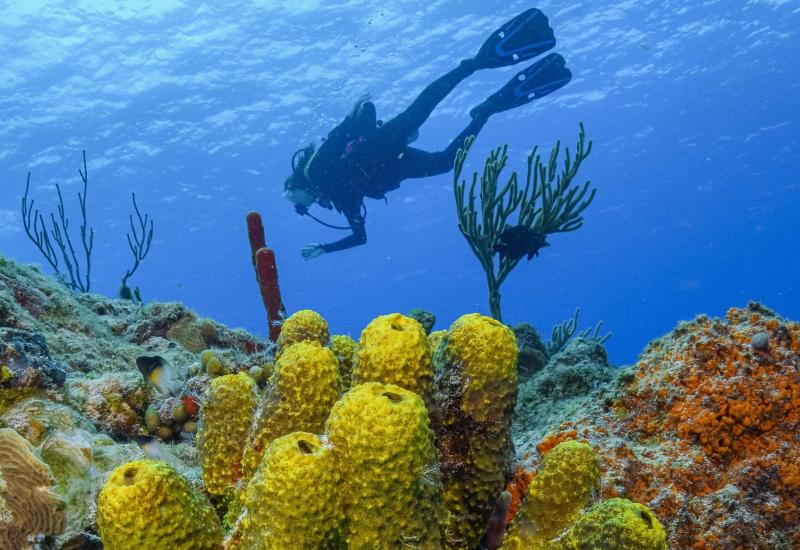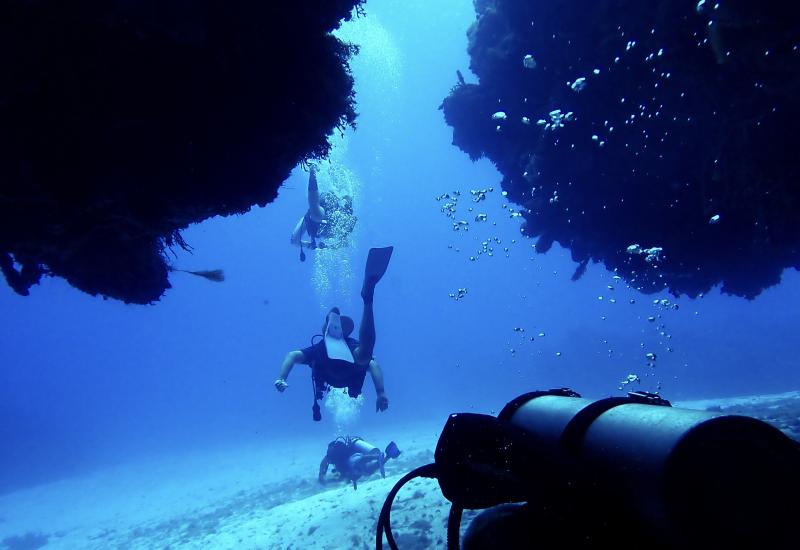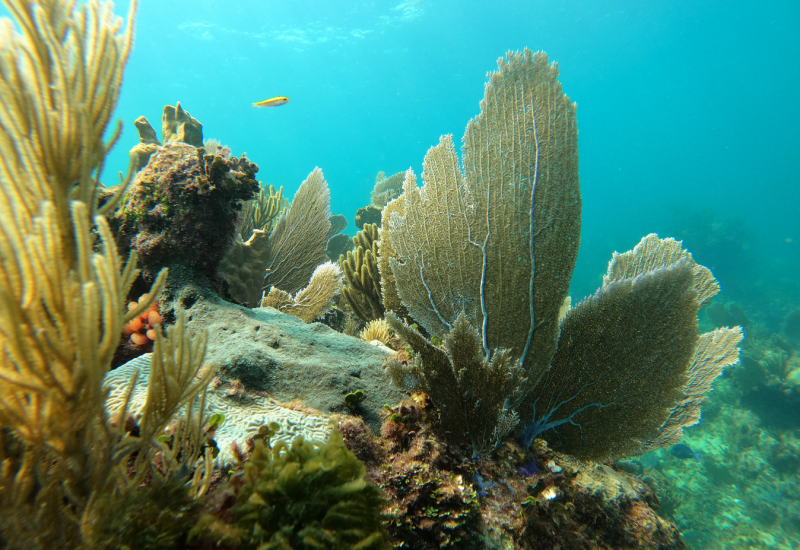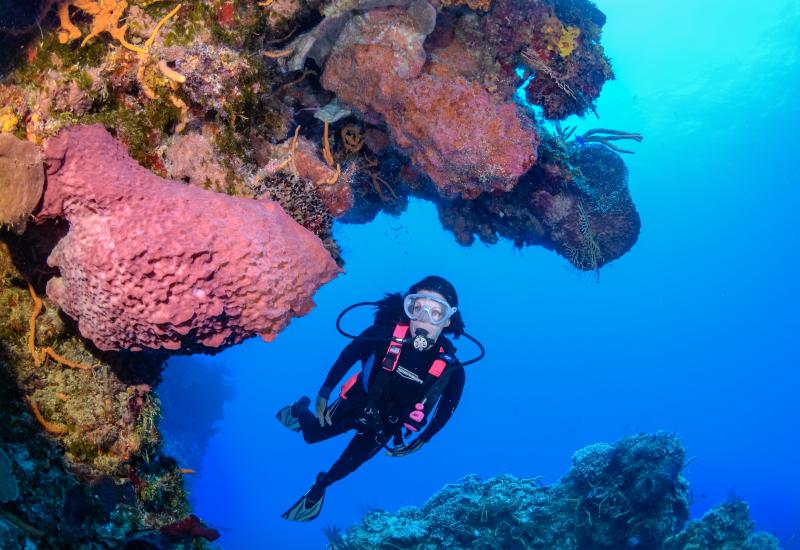Scuba Diving in Cozumel
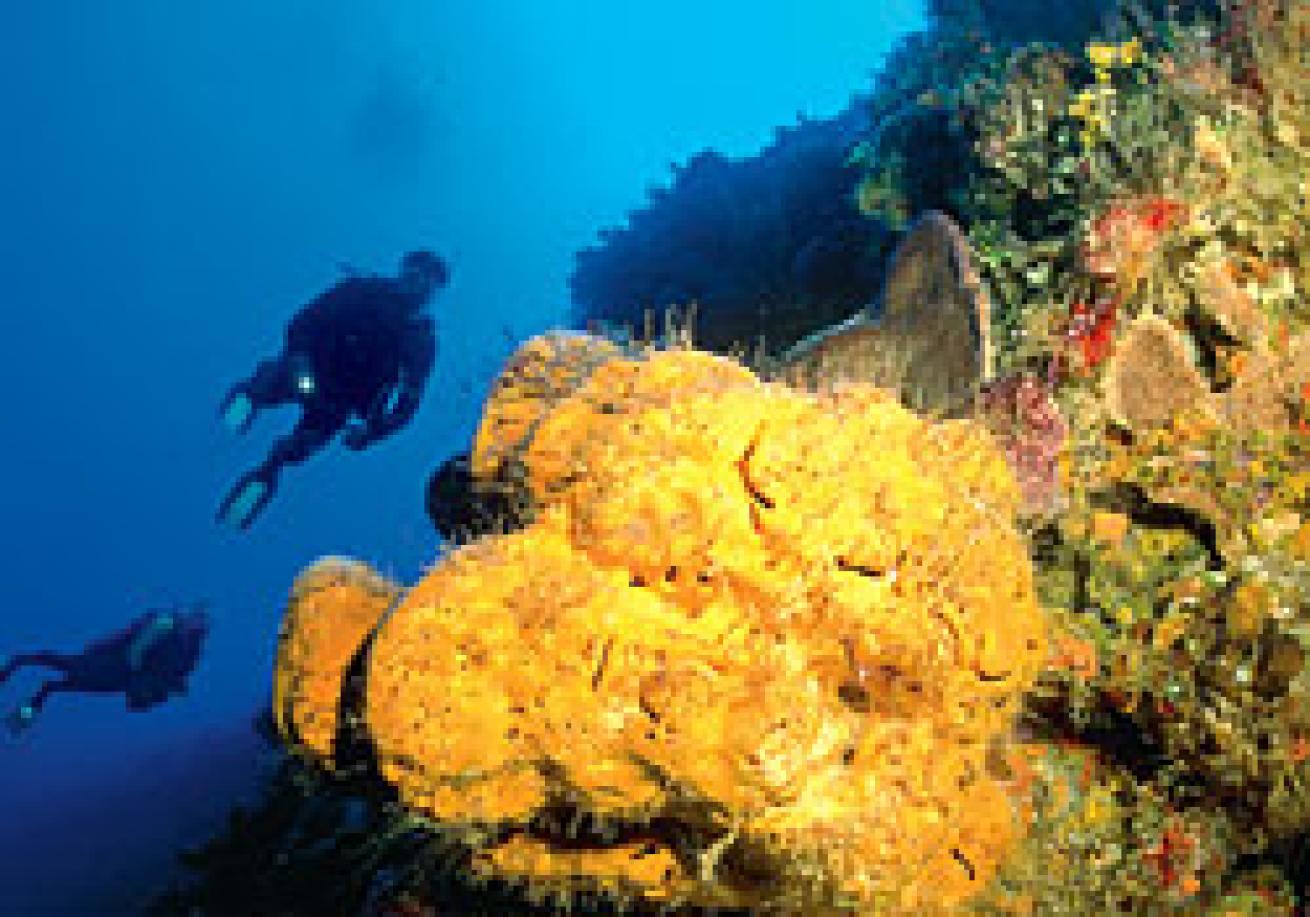
Welcome. For those of you who have never been, listen and learn. For those of you who simply can't stop going, please stand up, state your name and admit, "I am a Cozumel addict. I last was in Cozumel (last week/yesterday/I just flew in this morning). It was my (fourth/sixth/tenth) trip there this year. I know I should try diving another destination, but Cozumel is always there and has never, ever disappointed me."
Sound familiar? If you're standing, you're not alone. Palancar and Columbia, two Cozumel reefs, were rated the two most popular dive sites in the world in Scuba Diving's annual "Top 100." Combine that with easy access, only a two-hour flight from most U.S. gateways, and bargain-basement prices year-round, it is understandable, if not inevitable that divers flock to Mexico's largest Caribbean island like the faithful on a pilgrimage to Mecca. So, those who have already made the journey, don't feel guilty about planning your return, and those who are just contemplating the journey: Come, join those of us who know that flying doesn't have to be just a dream.
What's So Addictive About Cozumel?
The Guiana Current has been blasting around Cozumel for eons, shaping the coastline and forming intricate patterns of limestone and reef. Lush coral ridges line the shore, with drop-offs punctuated by lobster-infested pinnacles, colorful sponge and star coral. There are plenty of ingredients here to hook you--here are some that snared us.
The Convenience
With direct flights from many popular U.S. gateways, it's understandable why the hopelessly addicted fly down for a long weekend fix.
From Canada and other U.S. gateways it can be nearly as quick to fly to Cancun, then hop on a ferry or shuttle flight to Cozumel.
The Selection
Although one of the undisputable lures of Cozumel is the relatively low price of a dive vacation here, don't make cost your top priority when choosing a dive operator. There are more than 100 dive services on this little island, and you've got a great opportunity to investigate and find an operation you not only feel comfortable with, but one that you actually have a blast diving with. Face the facts: You're going to come back to Cozumel again and again. It's worth finding a group of divers you like to hang with.
A few tips to help narrow down your search: first, cross off the ragtag fishing boats hawking their services on the street corners. You've already saved major bucks on airfare and lodging, don't go overboard. What you have left falls neatly into two categories: large dive operators, often associated with a particular hotel, and independent dive shops.
Without a doubt, first-timers, novice divers and large groups need look no further than one of the large operators. They offer the full range of certification courses, attentive divemasters and large, spacious vessels with rinse buckets, coolers full of Cokes and lots of camaraderie. Many advanced divers also choose these operators because they often have programs designed for experienced divers and a fleet of small, fast boats and savvy guides.
Experienced Cozumel divers usually have a regular supplier. It is important to determine whether smaller operators are licensed to dive in the National Marine Park and have the necessities — radio, oxygen and first-aid — on the boat. A small fast boat with a maximum of six divers is ideal. The ride can be rough, but it's quick and the group will be small and dive-savvy. Your days fill up with backrolls and deep depths, often bordering on deco. You've got to have a computer to be on this kind of a boat.
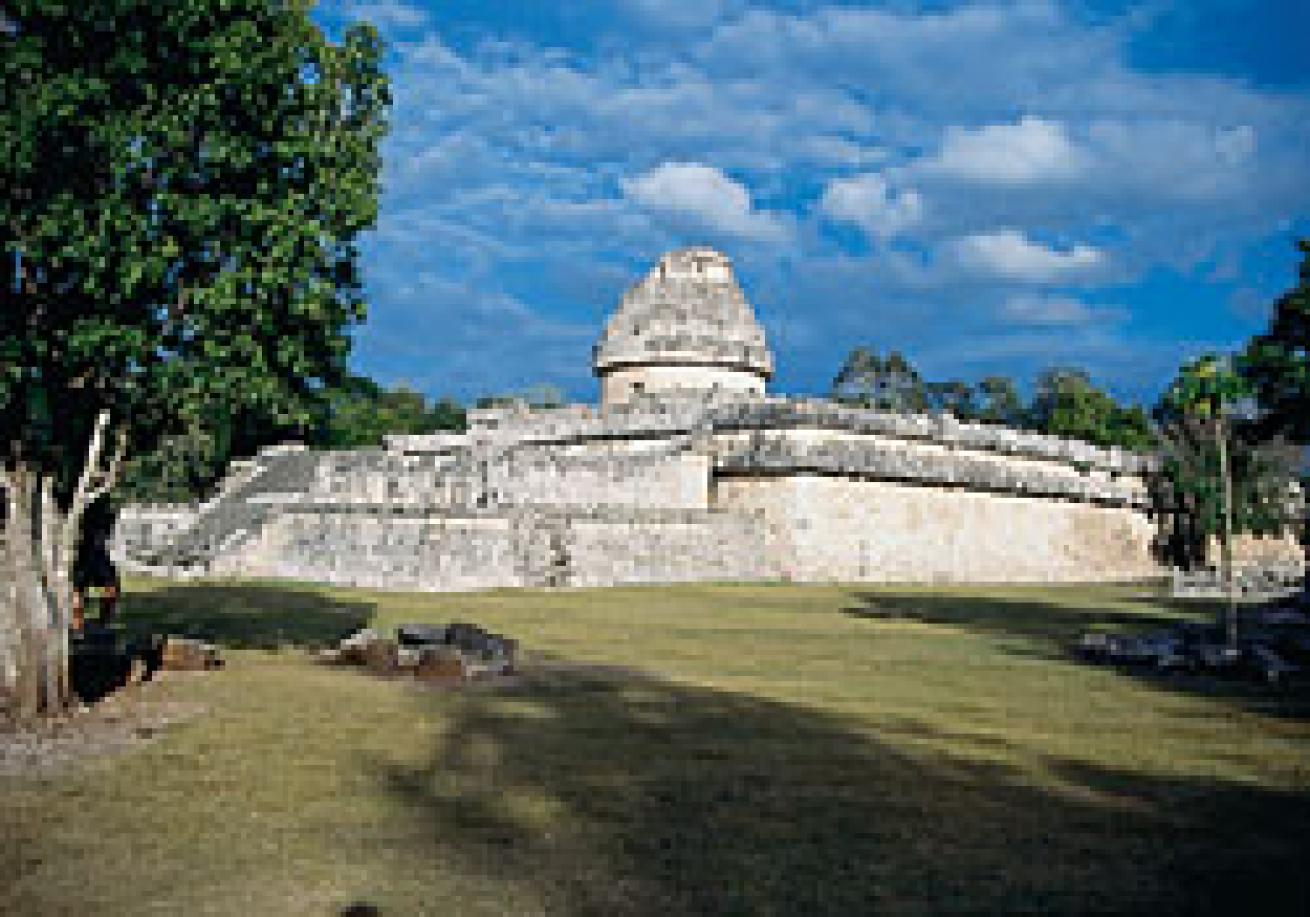
The Thrill
Within seconds of your giant stride, the current has you--and the divemaster and the rest of your group. Relax, don't fight it. Instead, follow your divemaster's lead and these tips, and you'll be begging for more.
Descend quickly. Once the signal for descent has been given, be prepared to deflate your BC and begin equalizing immediately.
Neutralize your buoyancy. Once at depth, get neutrally buoyant. Yes, to avoid contact with the reef and to keep from silting up swim-throughs, but also for safety reasons; many of Cozumel's walls that you'll be diving won't have a bottom to stop your descent for 3,000 feet.
Stay with your buddy--the group. Because of the nature of "live boat" diving, where the captain of the dive boat follows divers' bubbles, it is necessary to stay with the group. We're divers, not sardines, so just be sure to stay in visual contact--normally about 100 feet--with the leader.
Ascend with awareness. After your drifting safety stop, look to the surface for your boat, and any boat traffic. If you do see your boat, ascend approximately 10 to 15 feet from the stern and swim to the ladder. If you do not see your boat, inflate your safety sausage and ascend.
The Atmosphere
Old-time Cozzies still feel a sting as they pass the northern section of Paradise Reef, now a parking lot for the Love Boat that dispenses hundreds of tourists a day thirsty for the indiscretions of Carlos and Charlie's and eager to add a Cozumel Hard Rock Cafe T-shirt to their collection. Among the regulars, it has become a challenge and a pleasure to discover the hidden topside treasures of Cozumel where there are no parking lots for the crowd.
Cerveza and a sunset. Rent a car for the afternoon — many hotels offer on-site vehicle rentals — and head south, stopping at Chankanaab Park if you're in the mood for a stroll through botanical gardens and transplanted Mayan ruins. Plan to land at one of the seaside bars on the southern tip of the island a little before sunset where hammocks on the beach sway in the wind.
Local eats. There are dozens of great restaurants in San Miguel. Be sure to try a real Mexican margarita wherever you go. But if you want some variety after your fifth night, ask a local for a recommendation.
Hop the Ferry. From the main pier you can catch the ferry to Playa del Carmen. Rent a car and head south to the Tulum or Xel-Há Maya ruins, or spend the day diving Yucatan's world-famous cenotes.
The Terrain
The coral ridge that parallels Cozumel's coast offers up vertical walls, spur-and-groove formations that have been sculpted over the millennia into coral pinnacles with tunnels and swim-throughs, and protected nearshore coral gardens where the standard for long bottom times was set. Turn the page for a sampling of each.
Planning Your Return
Before you leave Cozumel you might find yourself standing in front of your hotel mirror and seeing the telltale signs of a Cozumel addict--a slight sunburn, a stupid grin on your face and a few bucks still crumpled in your wallet (don't do this too early in the morning or you might also have a slight margarita headache). You owe it to yourself to prepare for the worst--you might come back next month. Go ahead and figure out where you want to go next time. Get some names and phone numbers, make a few arrangements.
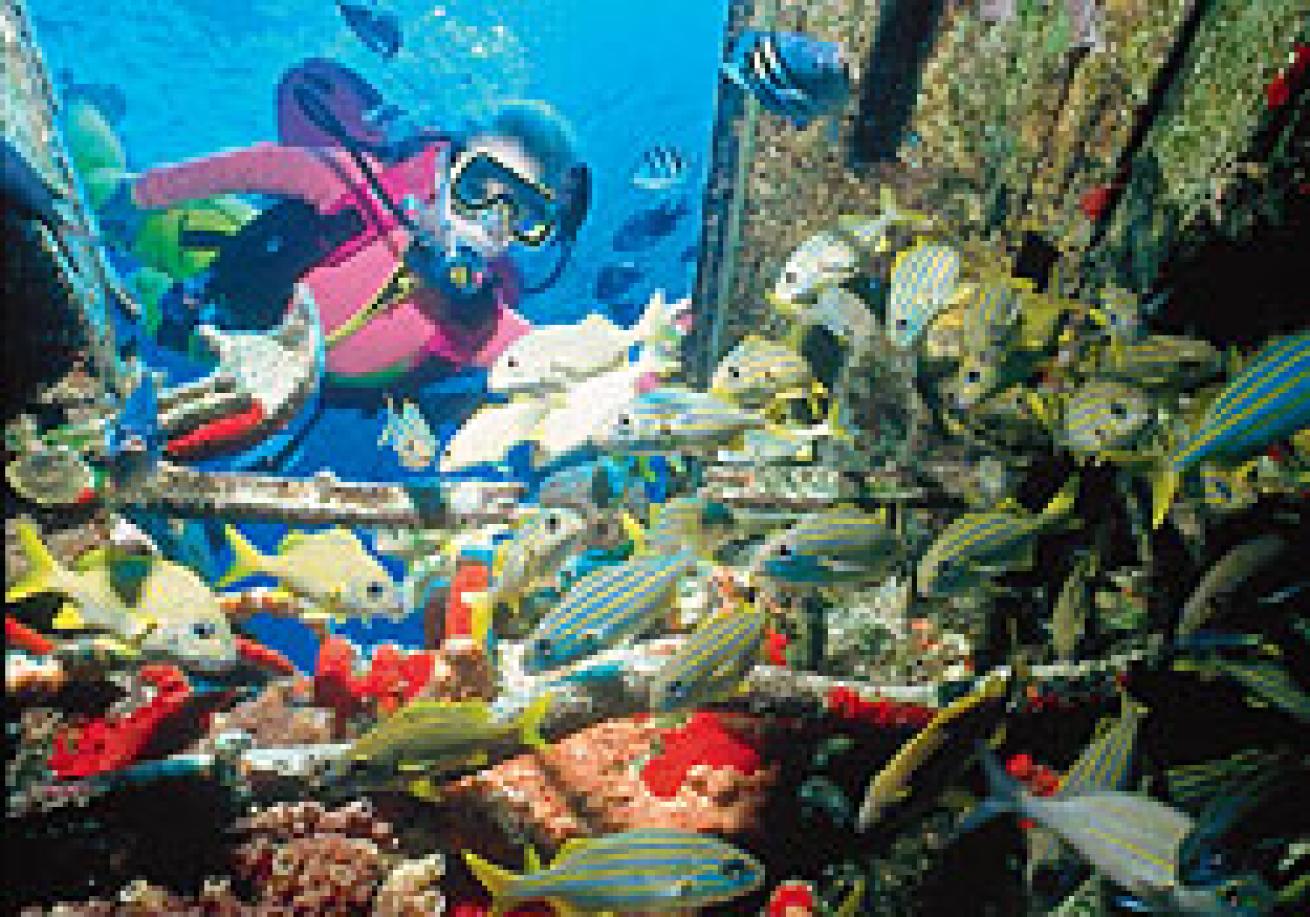
Cozumel Diving Terrain
Nearshore Coral Gardens
The shallows between the shore and drop-off are filled with patch reefs and coral ridges and rich with tropical fish. Sites close to the drop-off tend to have the swiftest currents and are home to the biggest examples of Cozumel marine life.
Chankanaab
Depth: 55 feet
Skill Level: Beginner
Current: Mild
This popular patch reef can be accessed from the shore of Chankanaab Park, but the deeper section of this inner reef is a second boat dive and is dense with marine life. Gorgonians undulate from coral outcroppings where grunts and jacks congregate, and the gentle current allows for the opportunity to remain stationary to spot moray eels and the endemic splendid toadfish under the ledges.
Yucab
Depth: 40 to 60 feet
Skill Level: Beginner to Intermediate
Current: Moderate to strong
This is a divemaster favorite, so expect yours to suggest this as the second dive of the day. Don't hesitate. Blue tang, triggerfish and trunkfish populate this low-profile, but dense inner ridge. Purple vase sponges teeter to one side, sculpted by the current to look like your first-grader's clay pot and otherwise healthy stovepipe sponges look as if they've been run over by a Mack truck. Be sure to look under the archways and ledges for jewfish and lobster.
Paradise Reef South
Depth: 45 feet
Skill Level: Beginner
Current: Nonexistent to mild
This long stretch of shallow reef was made for lazy afternoons and long bottom times. Easily accessible from shore and pier, it is a popular night dive and perfect for macro photographers.
Coral Pinnacles
These sites have a picket line of towering coral pinnacles and broad coral buttresses. Diving these sites is like wending your way through a coral maze of tunnels, canyons, archways and swim-throughs.
Punta Sur
Depth: 70 to 130 feet
Skill Level: Advanced
Current: Moderate
This site demands pinpoint-perfect buoyancy skills and a dive computer. Sandy channels lead to coral tunnels, which in turn lead to the deep water. Take a good look out into the twilight for sharks and rays before making your way back through Devil's Throat.
Palancar Caves
Depth: 40 to 120-plus feet
Skill Level: Intermediate
Current: Moderate to strong
Like a line of tenement houses in a Dickens novel, the deep coral buttresses of Palancar house a cast of characters that will make you cry for more--huge jewfish, grouper and schools of glassy sweepers. There are countless caves, swim-throughs and archways spread thick with orange sponge and star coral.
Columbia Pinnacles
Depth: 60 to 90 feet
Skill Level: Intermediate
Current: Moderate
This reef has it all: dazzling color, prodigious coral growth, swim-throughs and coral pinnacles resting at 90 feet on a white sand bottom. Bring your wide-angle lens and be prepared to want to return. But, as predictable as the vis is at 100 feet here, the current is just as unpredictable, often strong and variable in direction.
Vertical Walls
There's nothing like a classic vertical wall to get a diver's heart pounding. Look for plate corals, monstrous sponges, deepwater gorgonians and a variety of reef and pelagic species.
Santa Rosa Wall
Depth: 30 to 130 feet
Skill Level: Intermediate
Current: Strong
Rope sponges and plate corals tumble down Santa Rosa's near-vertical wall, which is made up of coral buttresses shrouded by monstrous sponges and deep-water gorgonians. Personable groupers trail you through the reef cuts where ledges and overhangs hide the shy ones.
Maracaibo Deep
Depth: 70 to 140-plus feet
Skill Level: Advanced
Current: Moderate to strong
This is the place to come if your razón d'estar is to encounter the big stuff--blacktips, reef sharks and schools of mantas and eagle rays. Of course there is never a guarantee, but this sheer drop-off, which starts at 120 feet, offers the thrill of the unexpected.
The Wildlife
Since the advent of the National Marine Park in 1996, absolutely no harvesting of marine life is permitted between Paradise Reef and the southern tip of the island. These protected waters are brimming with a variety of tropical and reef fish. Here are several commonly sighted fish on Cozumel's reefs, according to Reef Environmental Education Foundation (REEF), plus a few to challenge your fish- spotting skills.
Blue Tang Found in loose schools feeding on algae on Yucab's reef top and other shallow reefs.
Sharpnose Puffer The bright eyes and pointed snout of this triangular puffer make it easy to identify. It's an omnivore, feeding both on sea grass beds and on reefs like Palancar.
Balloonfish With iridescent eyes, long spines and a shy nature, these solitary fish are a coveted find for macro photographers. Look in coral crevices on Paradise Reef.
Whitespotted filefish These long-snouted, odd-shaped fish are gray and orange with a white-spotted overlay. They can grow up to two feet and are found in pairs on reefs such as Yucab.
Splendid toadfish Nowhere else in the world can you see this reclusive toadfish, but consider yourself lucky if you see more than its barbed and zebra-striped head peering out from a dark recess.
Blue Chromis Feeding on the nutrient-rich currents that sweep the reef, great schools of this diminutive fish are great company during a safety stop.
Glassy Sweeper These copper-colored nocturnal feeders are often found in large schools in Punta Sur's caves and grottoes.
Cenotes - Windows to Heaven
If you feel like ducking out of the current one day and into the stillness of the inside of the world, look no further than Yucatan's cenotes, voted number one in Scuba Diving's "Top 100" for the best visibility in the Caribbean/Atlantic region. They are worth a day trip to the mainland, but if you just can't tear yourself from the drama of drift diving, arrange to try Cozumel's shortcut answer to diving Mexico's cenotes.
Unlike the mainland's cenotes of the Nohoch Nah Chich cave system, Cozumel cenotes are smaller, half salt and half fresh water and do not have jaw-dropping formations accessible by open-water divers. Nonetheless, it is an explorer's delight to go where few have gone before. But, if you are cave certified, get down there now — the cave system is extensive, full of formations and still not fully explored. You might even have a shot at discovering and naming a new cave, after your madre, of course.
Cenote Diving Tips & Techniques
Modify your kick. To avoid kicking up silt in your buddy's face, use a modified frog kick. Bend your knees 90 degrees and your ankles 90 degrees so your fins are parallel to the bottom but above your body. Now rotate your fins outward and snap them together.
Use the rule of thirds. In overhead environments with an 80-cubic-foot tank, monitor your air so you use 1,000 psi going in, 1,000 psi coming out and are left with 1,000 psi in case of emergency.
Be aware of the line. Most mainland cenotes have lines permanently secured for easy navigation. Don't get too close to the line, or your gauges, fin straps or camera equipment may get hopelessly tangled.
Equalize early and often. Many cenotes have air chambers and sinkholes where you can surface during the dive. The sawtooth profile often causes ear problems. Be prepared to equalize throughout your dive.
Know your command signs. Here are a few of the flashlight signals that you must know. Making a circle with your light means "OK." Waving your light horizontally means "emergency" and up and down is "attention."
Drop the weight. Unless you're using a thicker wetsuit, drop your weight by 40 percent if you're diving mainland cenotes, less if you're diving Cozumel's cenotes, which have a higher concentration of salt water.
Don't touch. Stalagtites and stalactites are as delicate as the reef and have taken as many thousands of years to develop. Clip off your gauges and be conscious of where your fins are at all times.
Dive In
Water Conditions: Water temperatures vary from mid- to high 70Fs in winter to 85F in summer, and you can count on 100 honest feet of visibility year-round.
Climate: Cozumel averages a balmy year-round temperature of about 80F, though humidity and bright sunlight can turn up the heat index. During the May to October rainy season, expect regular, fast-moving afternoon thundershowers that quickly drench the island. Nights can be on the cool side in winter.
Documents: Passport.
Getting Around: Shuttle vans or rental cars are the only transportation from the airport and make the circuit to all the hotels. Cabs are readily available at all hotels or you can wave one off the street. Fares are set by the drivers' union and most cabbies are honest about them. Short rides start at US$4. You can also rent jeeps, cars and scooters.
Language: Spanish, though English is widely spoken, especially at hotels, dive shops and major restaurants.
Money: The Mexican peso floats against the U.S. dollar and is prone to fluctuations.
Electricity: 110 volts/60 cycles.
Time: Cozumel is in the Central time zone and doesn't observe daylight savings time.
In Case Of Emergency: The local recompression chamber is on-call 24 hours a day.

